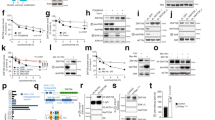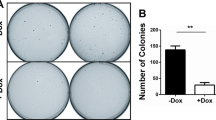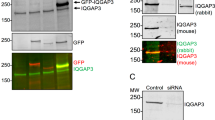Abstract
Ras is one of the most frequently activated oncogenes in cancer. Two mitogen-activated protein kinases (MAPKs) are important for ras transformation: extracellular signal-regulated kinase (ERK) and c-Jun N-terminal kinase 2 (JNK2). Here we present a downstream signal amplification cascade that is critical for ras transformation in murine embryonic fibroblasts. This cascade is coordinated by ERK and JNK2 MAPKs, whose Ras-mediated activation leads to the enhanced levels of three oncogenic transcription factors, namely, c-Myc, activating transcription factor 2 (ATF2) and ATF3, all of which are essential for ras transformation. Previous studies show that ERK-mediated serine 62 phosphorylation protects c-Myc from proteasomal degradation. ERK is, however, not alone sufficient to stabilize c-Myc but requires the cooperation of cancerous inhibitor of protein phosphatase 2A (CIP2A), an oncogene that counteracts protein phosphatase 2A-mediated dephosphorylation of c-Myc. Here we show that JNK2 regulates Cip2a transcription via ATF2. ATF2 and c-Myc cooperate to activate the transcription of ATF3. Remarkably, not only ectopic JNK2, but also ectopic ATF2, CIP2A, c-Myc and ATF3 are sufficient to rescue the defective ras transformation of JNK2-deficient cells. Thus, these data identify the key signal converging point of JNK2 and ERK pathways and underline the central role of CIP2A in ras transformation.
This is a preview of subscription content, access via your institution
Access options
Subscribe to this journal
Receive 50 print issues and online access
$259.00 per year
only $5.18 per issue
Buy this article
- Purchase on Springer Link
- Instant access to full article PDF
Prices may be subject to local taxes which are calculated during checkout






Similar content being viewed by others
References
Alarcon-Vargas D, Ronai Z . (2004). c-Jun-NH2 kinase (JNK) contributes to the regulation of c-Myc protein stability. J Biol Chem 279: 5008–5016.
Amati B, Frank SR, Donjerkovic D, Taubert S . (2001). Function of the c-Myc oncoprotein in chromatin remodeling and transcription. Biochim Biophys Acta 1471: M135–M145.
Behrens A, Jochum W, Sibilia M, Wagner EF . (2000). Oncogenic transformation by ras and fos is mediated by c-Jun N-terminal phosphorylation. Oncogene 19: 2657–2663.
Berger AJ, Kluger HM, Li N, Kielhorn E, Halaban R, Ronai Z et al. (2003). Subcellular localization of activating transcription factor 2 in melanoma specimens predicts patient survival. Cancer Res 63: 8103–8107.
Bhoumik A, Gangi L, Ronai Z . (2004). Inhibition of melanoma growth and metastasis by ATF2-derived peptides. Cancer Res 64: 8222–8230.
Bhoumik A, Ronai Z . (2008). ATF2: a transcription factor that elicits oncogenic or tumor suppressor activities. Cell Cycle 7: 2341–2345.
Binetruy B, Smeal T, Karin M . (1991). Ha-Ras augments c-Jun activity and stimulates phosphorylation of its activation domain. Nature 351: 122–127.
Bost F, McKay R, Bost M, Potapova O, Dean NM, Mercola D . (1999). The Jun kinase 2 isoform is preferentially required for epidermal growth factor-induced transformation of human A549 lung carcinoma cells. Mol Cell Biol 19: 1938–1949.
Brunet A, Pages G, Pouyssegur J . (1994). Constitutively active mutants of MAP kinase kinase (MEK1) induce growth factor-relaxation and oncogenicity when expressed in fibroblasts. Oncogene 9: 3379–3387.
Cai Y, Zhang C, Naea T, Aso T, Tanaka M, Oshiro S et al. (2000). Homocysteine-responsive ATF3 gene expression in human vascular endothelial cells: activation of c-Jun NH2-terminal kinase and promoter response element. Blood 96: 2140–2148.
Chen N, Nomura M, She QB, Ma WY, Bode AM, Wang L et al. (2001). Suppression of skin tumorigenesis in c-Jun NH(2)-terminal kinase-2-deficient mice. Cancer Res 61: 3908–3912.
Ciardiello F, Valverius EM, Colucci-D'Amato GL, Kim N, Bassin RH, Salomon DS . (1990). Differential growth factor expression in transformed mouse NIH-3T3 cells. J Cell Biochem 42: 45–57.
Come C, Laine A, Chanrion M, Edgren H, Mattila E, Liu X et al. (2009). CIP2A is associated with human breast cancer aggressivity. Clin Cancer Res 15: 5092–5100.
Cowley S, Paterson H, Kemp P, Marshall CJ . (1994). Activation of MAP kinase kinase is necessary and sufficient for PC12 differentiation and for transformation of NIH 3T3 cells. Cell 77: 841–852.
Derijard B, Hibi M, Wu IH, Barrett T, Su B, Deng T et al. (1994). JNK1: a protein kinase stimulated by UV light and Ha-Ras that binds and phosphorylates the c-Jun activation domain. Cell 76: 1025–1037.
Dietrich N, Thastrup J, Holmberg C, Gyrd-Hansen M, Fehrenbacher N, Lademann U et al. (2004). JNK2 mediates TNF-induced cell death in mouse embryonic fibroblasts via regulation of both caspase and cathepsin protease pathways. Cell Death Differ 11: 301–313.
Eilers M, Eisenman RN . (2008). Myc’s broad reach. Genes Dev 22: 2755–2766.
Fuchs SY, Tappin I, Ronai Z . (2000). Stability of the ATF2 transcription factor is regulated by phosphorylation and dephosphorylation. J Biol Chem 275: 12560–12564.
Furth ME, Davis LJ, Fleurdelys B, Scolnick EM . (1982). Monoclonal antibodies to the p21 products of the transforming gene of Harvey murine sarcoma virus of the cellular ras gene family. J Virol 43: 294–304.
Guccione E, Martinato F, Finocchiaro G, Luzi L, Tizzoni L, Dall' Olio V et al. (2006). Myc-binding-site recognition in the human genome is determined by chromatin context. Nat Cell Biol 8: 764–770.
Gupta S, Barrett T, Whitmarsh AJ, Cavanagh J, Sluss HK, Dérijard B et al. (1996). Selective interaction of JNK protein kinase isoforms with transcription factors. EMBO J 15: 2760–2770.
Gupta S, Campbell D, Derijard B, Davis RJ . (1995). Transcription factor ATF2 regulation by the JNK signal transduction pathway. Science 267: 389–393.
Hibi M, Lin A, Smeal T, Minden A, Karin M . (1993). Identification of an oncoprotein- and UV-responsive protein kinase that binds and potentiates the c-Jun activation domain. Genes Dev 7: 2135–2148.
Hubbard TJ, Aken BL, Ayling S, Ballester B, Beal K, Bragin E et al. (2009). Ensembl 2009. Nucleic Acids Res 37: D690–D697.
Jacobsen K, Groth A, Willumsen BM . (2002). Ras-inducible immortalized fibroblasts: focus formation without cell cycle deregulation. Oncogene 21: 3058–3067.
Johnson R, Spiegelman B, Hanahan D, Wisdom R . (1996). Cellular transformation and malignancy induced by ras require c-jun. Mol Cell Biol 16: 4504–4511.
Junttila MR, Puustinen P, Niemela M, Ahola R, Arnold H, Bottzauw T et al. (2007). CIP2A inhibits PP2A in human malignancies. Cell 130: 51–62.
Kallunki T, Su B, Tsigelny I, Sluss HK, Derijard B, Moore G et al. (1994). JNK2 contains a specificity-determining region responsible for efficient c-Jun binding and phosphorylation. Genes Dev 8: 2996–3007.
Kawagishi J, Kumabe T, Yoshimoto T, Yamamoto T . (1995). Structure, organization, and transcription units of the human alpha-platelet-derived growth factor receptor gene, PDGFRA. Genomics 30: 224–232.
Kawasaki H, Schiltz L, Chiu R, Itakura K, Taira K, Nakatani Y et al. (2000). ATF-2 has intrinsic histone acetyltransferase activity which is modulated by phosphorylation. Nature 405: 195–200.
Ke H, Harris R, Coloff JL, Jin JY, Leshin B, de Marval PM et al. (2010). The c-Jun NH2-terminal kinase 2 plays a dominant role in human epidermal neoplasia. Cancer Res 70: 3080–3088.
Kemp CJ . (2005). Multistep skin cancer in mice as a model to study the evolution of cancer cells. Semin Cancer Biol 15: 460–473.
Khanna A, Bockelman C, Hemmes A, Junttila MR, Wiksten JP, Lundin M et al. (2009). MYC-dependent regulation and prognostic role of CIP2A in gastric cancer. J Natl Cancer Inst 101: 793–805.
Khosravi-Far R, White MA, Westwick JK, Solski PA, Chrzanowska-Wodnicka M, Van Aelst L et al. (1996). Oncogenic Ras activation of Raf/mitogen-activated protein kinase-independent pathways is sufficient to cause tumorigenic transformation. Mol Cell Biol 16: 3923–3933.
Kolch W, Heidecker G, Lloyd P, Rapp UR . (1991). Raf-1 protein kinase is required for growth of induced NIH/3T3 cells. Nature 349: 426–428.
Krautwald S, Büscher D, Kummer V, Buder S, Baccarini M . (1996). Involvement of the protein tyrosine phosphatase SHP-1 in Ras-mediated activation of the mitogen-activated protein kinase pathway. Mol Cell Biol 16: 5955–5963.
Kyriakis JM, Banerjee P, Nikolakaki E, Dai T, Rubie EA, Ahmad MF et al. (1994). The stress-activated protein kinase subfamily of c-Jun kinases. Nature 369: 156–160.
Land H, Chen AC, Morgenstern JP, Parada LF, Weinberg RA . (1986). Behavior of myc and ras oncogenes in transformation of rat embryo fibroblasts. Mol Cell Biol 6: 1917–1925.
Livingstone C, Patel G, Jones N . (1995). ATF-2 contains a phosphorylation-dependent transcriptional activation domain. EMBO J 14: 1785–1797.
Lopez-Bergami P, Kim H, Dewing A, Goydos J, Aaronson S, Ronai Z . (2010). c-Jun regulates phosphoinositide-dependent kinase 1 transcription: implication for Akt and protein kinase C activities and melanoma tumorigenesis. J Biol Chem 285: 903–913.
Malumbres M, Barbacid M . (2003). RAS oncogenes: the first 30 years. Nat Rev Cancer 3: 459–465.
Mansour SJ, Matten WT, Hermann AS, Candia JM, Rong S, Fukasawa K et al. (1994). Transformation of mammalian cells by constitutively active MAP kinase kinase. Science 265: 966–970.
Martinato F, Cesaroni M, Amati B, Guccione E . (2008). Analysis of Myc-induced histone modifications on target chromatin. PLoS One 3: e3650.
Mei Y, Yuan Z, Song B, Li D, Ma C, Hu C et al. (2008). Activating transcription factor 3 up-regulated by c-Jun NH(2)-terminal kinase/c-Jun contributes to apoptosis induced by potassium deprivation in cerebellar granule neurons. Neuroscience 151: 771–779.
Nielsen C, Thastrup J, Bottzauw T, Jaattela M, Kallunki T . (2007). c-Jun NH2-terminal kinase 2 is required for Ras transformation independently of activator protein 1. Cancer Res 67: 178–185.
Nielsen KH, Gredsted L, Broach JR, Willumsen BM . (2001). Sensitivity of wild type and mutant ras alleles to Ras specific exchange factors: identification of factor specific requirements. Oncogene 20: 2091–2100.
Noguchi K, Kitanaka C, Yamana H, Kokubu A, Mochizuki T, Kuchino Y . (1999). Regulation of c-Myc through phosphorylation at Ser-62 and Ser-71 by c-Jun N-terminal kinase. J Biol Chem 274: 32580–32587.
Ovaska K, Laakso M, Haapa-Paananen S, Louhimo R, Chen P, Aittomäki V et al. (2010). Large-scale data integration framework provides a comprehensive view on glioblastoma multiforme. Genome Med 2: 65.
Pearn L, Fisher J, Burnett AK, Darley RL . (2007). The role of PKC and PDK1 in monocyte lineage specification by Ras. Blood 109: 4461–4469.
Perez S, Vial E, van Dam H, Castellazzi M . (2001). Transcription factor ATF3 partially transforms chick embryo fibroblasts by promoting growth factor-independent proliferation. Oncogene 20: 1135–1141.
Potapova O, Gorospe M, Bost F, Dean NM, Gaarde WA, Mercola D et al. (2000). c-Jun N-terminal kinase is essential for growth of human T98G glioblastoma cells. J Biol Chem 275: 24767–24775.
Raingeaud J, Gupta S, Rogers JS, Dickens M, Han J, Ulevitch RJ et al. (1995). Pro-inflammatory cytokines and environmental stress cause p38 mitogen-activated protein kinase activation by dual phosphorylation on tyrosine and threonine. J Biol Chem 270: 7420–7426.
Schimanski CC, Zimmermann T, Schmidtmann I, Gockel I, Lang H, Galle PR et al. (2010). K-Ras mutation status correlates with the expression of VEGFR1, VEGFR2, and PDGFRalpha in colorectal cancer. Int J Colorectal Dis 25: 181–186.
Sears R, Leone G, DeGregori J, Nevins JR . (1999). Ras enhances Myc protein stability. Mol Cell 3: 169–179.
Sears R, Nuckolls F, Haura E, Taya Y, Tamai K, Nevins JR . (2000). Multiple Ras-dependent phosphorylation pathways regulate Myc protein stability. Genes Dev 14: 2501–2514.
Sharma A, Luke CT, Dower NA, Stone JC, Lorenzo PS . (2010). RasGRP1 is essential for ras activation by the tumor promoter 12-O-tetradecanoylphorbol-13-acetate in epidermal keratinocytes. J Biol Chem 285: 15724–15730.
Smeal T, Binetruy B, Mercola DA, Birrer M, Karin M . (1991). Oncogenic and transcriptional cooperation with Ha-Ras requires phosphorylation of c-Jun on serines 63 and 73. Nature 354: 494–496.
Tamura K, Hua B, Adachi S, Guney I, Kawauchi J, Morioka M et al. (2005). Stress response gene ATF3 is a target of c-myc in serum-induced cell proliferation. EMBO J 24: 2590–2601.
Teruel T, Valverde AM, Navarro P, Benito M, Lorenzo M . (1998). Inhibition of PI 3-kinase and RAS blocks IGF-I and insulin-induced uncoupling protein 1 gene expression in brown adipocytes. J Cell Physiol 176: 99–109.
Tournier C, Hess P, Yang DD, Xu J, Turner TK, Nimnual A et al. (2000). Requirement of JNK for stress-induced activation of the cytochrome c-mediated death pathway. Science 288: 870–874.
Troppmair J, Bruder JT, Munoz H, Lloyd PA, Kyriakis J, Banerjee P et al. (1994). Mitogen-activated protein kinase/extracellular signal-regulated protein kinase activation by oncogenes, serum, and 12-O-tetradecanoylphorbol-13-acetate requires Raf and is necessary for transformation. J Biol Chem 269: 7030–7035.
Wang A, Arantes S, Yan L, Kiguchi K, McArthur MJ, Sahin A et al. (2008). The transcription factor ATF3 acts as an oncogene in mouse mammary tumorigenesis. BMC Cancer 8: 268.
Yao D, Brownlee M . (2010). Hyperglycemia-induced reactive oxygen species increase expression of the receptor for advanced glycation end products (RAGE) and RAGE ligands. Diabetes 59: 249–255.
Yin X, Dewille JW, Hai T . (2008). A potential dichotomous role of ATF3, an adaptive-response gene, in cancer development. Oncogene 27: 2118–2127.
Zeller KI, Jegga AG, Aronow BJ, O'Donnell KA, Dang CV . (2003). An integrated database of genes responsive to the Myc oncogenic transcription factor: identification of direct genomic targets. Genome Biol 4: R69.
Acknowledgements
This work was supported by the Danish Cancer Society (TK, MJ), the Danish Medical Research Council (TK), Ellen and Aage Fausbøll Helsefond (TK), the Danish National Research Foundation (MJ), Danish Cancer Research Foundation (CE), the Novo Nordisk Foundation (CE), the Academy of Finland (JW, RL, SH), Competetive Research Funding of the Pirkanmaa Hospital District (JW, AK), the Finnish Cancer Society (JW, SH) and the Finnish Cancer Organizations (RL) and the Finnish Microarray and Sequencing Centre at Turku Centre for Biotechnology. We additionally thank Dr G Nolan for the pB-puro and pB-hygro constructs, Dr H Land for the c-Myc pB-puro construct, Dr S Kitajima for the ATF3 reporter constructs and Dr T Hai for the ATF3 construct. We are thankful for KG Henriksen and P Rammer for excellent assistance and LB Larsen and L Jørgensen for the in vivo tumorigenicity assay.
Author information
Authors and Affiliations
Corresponding author
Ethics declarations
Competing interests
The authors declare no conflict of interest.
Additional information
Supplementary Information accompanies the paper on the Oncogene website
Rights and permissions
About this article
Cite this article
Mathiasen, D., Egebjerg, C., Andersen, S. et al. Identification of a c-Jun N-terminal kinase-2-dependent signal amplification cascade that regulates c-Myc levels in ras transformation. Oncogene 31, 390–401 (2012). https://doi.org/10.1038/onc.2011.230
Received:
Revised:
Accepted:
Published:
Issue Date:
DOI: https://doi.org/10.1038/onc.2011.230
Keywords
This article is cited by
-
Altering phosphorylation in cancer through PP2A modifiers
Cancer Cell International (2024)
-
CIP2A silencing alleviates doxorubicin resistance in MCF7/ADR cells through activating PP2A and autophagy
Clinical and Translational Oncology (2021)
-
Second generation tyrosine kinase inhibitors prevent disease progression in high-risk (high CIP2A) chronic myeloid leukaemia patients
Leukemia (2015)
-
Label-free quantitative phosphoproteomics with novel pairwise abundance normalization reveals synergistic RAS and CIP2A signaling
Scientific Reports (2015)
-
Increased susceptibility of H-Ras G12V -transformed human urothelial cells to the genotoxic effects of sodium arsenite
Archives of Toxicology (2015)



